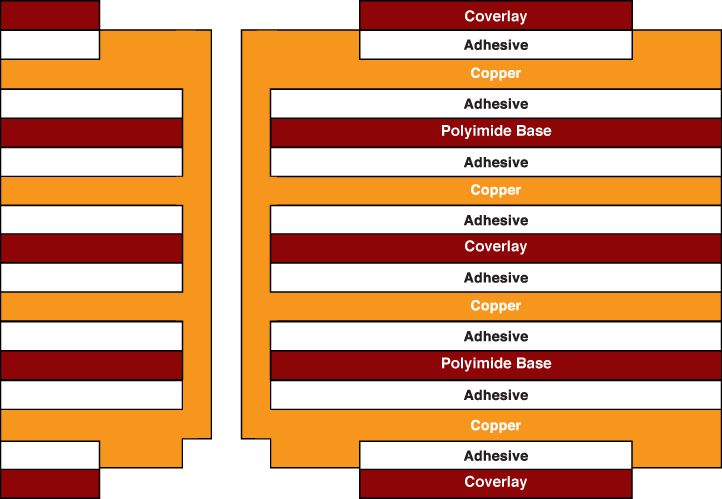A Multilayer Flexible Printed Circuit Board (FPCB), often referred to as a flex PCB or flex circuit, is a specialized type of printed circuit board that offers flexibility and the ability to have multiple layers of conductive traces. It is designed to provide electrical connections while being highly flexible, making it suitable for applications where traditional rigid PCBs are not feasible due to size, weight, or the need for conformability. Here’s an introduction to multilayer flexible PCBs:

- Flexibility: The primary distinguishing feature of a multilayer flexible PCB is its flexibility. These PCBs are made from flexible substrate materials, such as polyimide (PI) or polyester (PET), which allows them to bend, twist, and conform to the shape of the device or enclosure in which they are installed. This flexibility is particularly valuable in applications with tight spaces or irregular shapes.
- Multiple Layers: Multilayer flexible PCBs are capable of hosting multiple layers of conductive traces. This means that they can handle complex circuit designs, including densely populated components and intricate routing. The number of layers can vary, typically ranging from two to six or more.
- Lightweight: Flex PCBs are significantly lighter than rigid PCBs, making them suitable for applications where weight is a concern, such as aerospace, automotive, and portable consumer electronics.
- Space-Saving: The flexibility and thin profile of multilayer flexible PCBs can help save space within a device or system. They can be folded or bent to fit into compact spaces, allowing for more efficient use of available real estate.
- Reliability: Flex PCBs can offer high reliability because they have fewer solder joints compared to rigid boards. Fewer interconnections mean fewer points of potential failure, making them suitable for applications where durability and reliability are critical.
- High-Temperature Resistance: Many flexible substrates, like polyimide, offer excellent thermal resistance, allowing the PCB to operate in environments with elevated temperatures without deforming or losing electrical integrity.
- Cost-Effective Production: While the initial tooling and setup costs for flexible PCB production can be relatively high, they can be cost-effective for high-volume production runs due to the ability to produce multiple boards on a single panel.
- Applications: Multilayer flexible PCBs find application in a wide range of industries, including aerospace, automotive, medical devices, consumer electronics, industrial equipment, and more. They are commonly used in products such as smartphones, wearables, camera modules, and automotive control systems.
- Design Challenges: Designing multilayer flexible PCBs requires specialized knowledge and considerations. The flexibility of the material, bend radius, and the choice of components and soldering methods all play a critical role in the design process.
- Prototyping: Prototyping and testing of multilayer flexible PCBs are essential to ensure that they meet the specific requirements of the application. Rapid prototyping services are available to assist in the development and refinement of these boards.
In summary, multilayer flexible PCBs are a versatile solution for applications where flexibility, space savings, and reliability are key considerations. They offer a wide range of design possibilities and are crucial components in many modern electronic devices.

